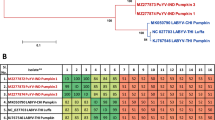Abstract
Symptoms like bright yellowing, puckering of the leaf, vein banding, and vein thickening were observed on different cucurbit hosts at the experimental farm of Indian Agricultural Research Institute, New Delhi during Kharif 2019. Leaf-dip electron microscopy of the symptomatic leaves revealed the association of isometric virus particles measuring ~ 25 nm with bitter gourd and cucumber samples. The RT-PCR assay using polerovirus generic primers covering the partial RdRp, intergenic region, and partial CP region was resulted the amplicons of ~ 1.1 kb. Subsequent cloning, sequencing, and sequence analysis revealed the association of cucurbit aphid-borne yellows virus (CABYV) with bitter gourd (Momordica charantia) and cucumber (Cucumis sativus) plants. These results constitute the first report of CABYV infection on cucumber plants from India.

Similar content being viewed by others
References
Costa TM, Blawid R, Aranda MA, Freitas DM, Andrade GP, Inoue-Nagata AK, Nagata T. Cucurbit aphid-borne yellows virus from melon plants in Brazil is an interspecific recombinant. Arch Virol. 2019;164:249–54.
Knierim D, Deng TC, Tsai WS, Green SK, Kenyon L. Molecular identification of three distinct Polerovirus species and a recombinant cucurbit aphid-borne yellows virus strain infecting cucurbit crops in Taiwan. Plant Pathol. 2010;59:991–1002.
Lecoq H, Bourdin D, Wipf-Scheibel C, Bon M, Lot H, Lemaire O, Herrbach E. A new yellowing disease of cucurbits caused by a luteovirus, cucurbit aphid-borne yellows virus. Plant Pathol. 1992;41:749–61.
Sangeetha B, Malathi VG, Renukadevi P. Emergence of cucurbit aphid-borne yellows virus in bitter gourd (Momordica charantia) in Tamil Nadu, India. Plant Dis. 2019;103:1441.
Suveditha S, Bharathi LK, KrishnaReddy M. First report of cucurbit aphid-borne yellows virus infecting bitter gourd (Momordica charantia) and teasel gourd (Momordica subangulata subsp. Renigera) in India. New Dis Rep. 2017;36:7.
Funding
Funding was provided by the Indian Council of Agricultural Research (IN), New Delhi (India).
Author information
Authors and Affiliations
Corresponding author
Additional information
Publisher's Note
Springer Nature remains neutral with regard to jurisdictional claims in published maps and institutional affiliations.
Supplementary information
Below is the link to the supplementary information.
Supplementary Figure 1.
Nucleotide sequence identity matrix generated based on partial RdRp, IR, and partial CP coding sequences of the bitter gourd and cucumber associated polerovirus of this study, in comparison with that of the other polerovirus isolates retrieved from the NCBI GenBank database. The isolates cloned and sequenced in the current study are marked with an asterisk. (PDF 208 kb)
Rights and permissions
About this article
Cite this article
Kumar, A., Bhattarai, A., Rathore, A.S. et al. Association of cucurbit aphid-borne yellows virus with cucumber plants in India. VirusDis. 32, 183–185 (2021). https://doi.org/10.1007/s13337-020-00645-4
Received:
Accepted:
Published:
Issue Date:
DOI: https://doi.org/10.1007/s13337-020-00645-4




